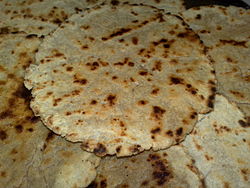Bhakri
 Bhakri | |
| Type | Bread |
|---|---|
| Place of origin | India |
| Region or state | Maharashtra, Gujarat, Malwa, Central India, Rajasthan and Goa |
| Main ingredients | Flour |
Bhakri (bhākri, bhakkari) is a round flat unleavened bread often used in the cuisine of the states of Maharashtra, Gujarat, Karnataka and Goa in India, along with several regions of western and central India, including areas of Rajasthan, Malwa, and Karnataka. It is coarser than a regular wheat roti. A simple Roti also said to be Bhakari, in various places of Maharashtra. Hence, it may or may not be referred as the special made meal in case of wheat bhakri,[1] i.e Chapati, Poli, etc. It can be either soft or hard in texture, similar to khakhra in respect to hardness.[2]
Details
Being a staple bread, bhakri is served with curd, chutney, baingan bharta, vegetables, and rice. It is made mostly from jowar flour, bakra flour, nachni (or finger millet) flour,[3] and mainly rice flour (in the Konkan region as well as in goa where in it is served mostly with fish currry). Bhakris are made primarily with hot water, and flour.[2] It has traditionally been the farmer's food[3] which would be carried to the farm at the crack of dawn and make up for both breakfast and lunch.
In the fields, bhakri even used to serve as a plate, on which chutney or thecha (chutney made of green chillies and peanuts) was served and eaten together. In modern days, bhakhri has been largely replaced by rotis and phulkas but still enjoys its own following. Typically bhakri is accompanied by pitla (a stew of gram flour)[3] but it may also be served with curry, garlic chutney, thecha (a thick paste of green or red chilies),[3] preparations of green leafy vegetables and raw onion. In some parts of north Karnataka it is served with stuffed brinjal curry. Bhakri is also eaten with Bharta/Bharit. In Vidarbha, it is eaten with "Zunka"- A coarse and thick variant of "Pithla."
Preparations

The dough for bhakri prepared by mixing the flour with small amount of salt in a bowl and knead into a smooth stiff dough, using enough hot water. The dough is split into little balls. The ball is then flattened using one's palms. There are 2 types by which is made. It is either flattened in the plate by palm by pressing or it is made thin by holding the ball in both palms which requires a lot of skill. The tava (pan) is heated and the bhakri is cooked applying little water to the upper surface and spread it all over with the help of your fingers. The other side also cooked on the tava. Once it is prepared, it is roasted in the direct flame on both the sides.[4]
Types of bhakri
- Wheat Bhakri - Wheat bhakris are like wheat rotis, but bigger in size and depth with proportionally more oil.
- Jowar bhakri - Jowar bhakris are the most common type of bhakri. The dough is prepared by mixing jowar flour with hot water and then flattened by hand. [5]
- Bajra bhakri - Bajra bhakris are mainly prepared in winter, especially near the festival of Sankrant. The preparation is similar to jowar bhakris. This is normally consumed with chutney and butter.
- Nachni bhakri - Nachni bhakhris, or ragi rottis, are made of red finger millets. They are prepared similar to other bhakris.
- Rice bhakri - Rice bhakhris are made of rice flour, prepared similarly to other bhakris. They are common in the Konkan region.
- Dalchini Bhakri - Dalchini bhakris are a newer variation[citation needed] of bhakris.[6] The dough is prepared by mixing wheat flour, cinnamon powder, butter, grated jaggery, and water. Cocoa powder may also be sprinked on later.[7]
See also
References
- ^ https://www.google.com/search?client=ms-unknown&ei=o-MhXOiJA9C7rQGw-KyoBw&q=भाकर+meaning+in+Marathi&oq=भाकर+meaning+in+Marathi&gs_l=mobile-gws-wiz-serp.3...6795.14702..15206...1.0..0.304.2905.2-8j3......0....1.........41j0i22i30j33i21.Krn_nsQ-7L0.
- ^ a b Taylor Sen, Colleen (2004). Food Culture in India. Greenwood Publishing Group. p. 41. ISBN 0-313-32487-5. Retrieved 2009-02-09.
- ^ a b c d Khatan, Asha. Epicure's Vegetarian Cuisines of India. Popular Prakashan. p. 57. ISBN 81-7991-119-5. Retrieved 2009-02-09.
- ^ Bhakri preparation
- ^ Jowar roti(Jolad rotti) – An easy way
- ^ 1000 Indian Recipe Cookbook. Arcturus Publishing. ISBN 978-1-78212-253-1.
- ^ Gautam Mehrishi. "Dalchini ki Bhakri". Livingfoodz.com.





